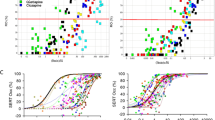Abstract
The ability and site of the metal-chelating 3-hydroxypyridin-4-ones (HPs) to mobilize aluminum (Al) was assessed in Al-loaded rats using microdialysis. Four HPs with greatly varying lipophilicity were studied. One week after Al loading, microdialysis probes were implanted in the liver, a jugular vein, and the frontal cortex. An HP was given iv followed by continuous microdialysis for 5 h. Al concentrations in dialysates from the liver increased rapidly and were consistently greater than from blood, suggesting that liver was a primary site of Al chelation. Brain dialysate Al concentrations remained low, suggesting little Al chelation in the brain and little distribution of the Al HP complex into the brain. Al concentrations were determined in the main organs/tissues of a separate group of Al-loaded rats, and the percentage of the total Al body burden in each organ/tissue was calculated. The skeletal system and liver had 57 and 28% of the Al body burden, consistent with the liver as a primary site of Al chelation. The HPs chelate extravascular Al and have been shown by others to be orally active. They warrant further investigation as Al chelators.
Similar content being viewed by others
References
P. O. Ganrot, Metabolism and possible health effects of aluminum,Environ. Health Perspect. 65, 363–411 (1986).
R. A. Yokel and P. J. McNamara, Elevated aluminum persists in serum and tissues of rabbits after a six-hour infusion,Toxicol. Appl. Pharmacol. 99, 133–138 (1989).
R. A. Yokel, Aluminum chelation: Chemistry, clinical and experimental studies and the search for alternatives to desferrioxamine.J. Toxicol. Environ. Health 41, 131–174 (1994).
R. C. Hider, S. Singh, J. B. Porter, and E. R. Huehns, The, development of hydroxypyridin-4-ones as orally active iron chelators.Ann. NY Acad. Sci. 612, 327–338 (1990).
R. A. Yokel, A. R. Data, and E. G. Jackson, Evaluation of potential aluminum chelators in vitro by aluminum solubilization ability, octanol/aqueous distribution and aluminum mobilization from transferrin,J. Pharmacol. Exp. Ther. 257, 100–106 (1991).
R. A. Yokel, V. Lidums, P. J. McNamara and U. Ungerstedt, Aluminum distribution into brain and liver of rats and rabbits following intravenous aluminum lactate or citrate: A microdialysis study,Toxicol. Appl. Pharmacol. 107, 153–163 (1991).
G. J. Kontoghiorghes, New concepts of iron and aluminium chelation therapy with oral L1 (deferiprone) and other chelators,Analyst 120, 845–851 (1995).
P. S. Dobbin, R. C., Hider, A. D. Hall, R. D. Taylor, P. Sarpong, J. B. Porter, G. Xiao, and D. van der Helm, Synthesis, physicochemical properties, and biological evaluation of N-substituted 2-alkyl-3-hydroxy-4(1H)-pyridinones: Orally active iron chelators with clinical potential,J. Med. Chem. 36, 2448–2458 (1993).
R. A. Yokel and J. M. Melograna, A safe method to acid digest small samples of biological tissues for graphite furnace atomic absorption analysis of aluminum,Biol. Trace Element Res. 5, 225–237 (1983).
R. Elorriaga, J. L. Fernández Martín, P. Menéndez Fraga, M. L. Naves, S. Braga and J. B. Cannata, Aluminium removal: short- and long-term preliminary results with L1 in rats,Drugs of Today 28(A), 177–182 (1992).
M. Gómez, J. L. Domingo, D. del Castillo, J. M. Llobet and J. Corbella, Comparative aluminium mobilizing actions of several chelators in aluminium-loaded uraemic rats,Hum. Exp. Toxicol. 13, 135–139 (1994).
G. J. Kontoghiorghes, J. Barr and R. A. Baillod, Studies of aluminium mobilization in renal dialysis patients using the oral chelator 1,2-dimethyl-3-hydroxypyrid-4-one,Arzneimittelforschung 44, 522–526 (1994).
S. D. Provan and R. A. Yokel, Reduced intestinal calcium and dietary calcium intake increase aluminum absorption and tissue concentrations in the rat.Biol. Trace Element Res. 23, 119–132 (1990).
A. C. Alfrey, A. Hegg, and P. Craswell, Metabolism and toxicity of aluminum in renal failure,Am. J. Clin. Nutr. 33, 1509–1516 (1980).
J. B. Porter M. Gyparaki, L. C. Burke, E. R. Huehns, P. Sarpong, V. Saez and R. C. Hider, Iron mobilization from hepatocyte monolayer cultures by chelators: The importance of membrane permeability and the iron-binding constant,Blood 72, 1497–1502 (1988).
S. Zevin, G. Link, R. W. Grady, R. C. Hider, H. H. Peter and C. Hershko, Origin and fate of iron mobilized by the 3-hydroxypyridin-4-one oral chelators: studies in hypertransfused rats by selective radioiron probes of reticuloendothelial and hepatocellular iron stores,Blood 79, 248–253 (1992).
R. A. Yokel, K. A. Meurer, T. L. Skinner and A. M. Fredenburg, The 3-hydroxypyridin-4-ones more effectively chelate aluminum in a rabbit model of aluminum intoxication than odes desferrioxamine,Drug Metab. Disp. 24, 105–111 (1996).
D. D. Allen, C. Orvig and R. A. Yokel, Evidence for energy-dependent transport of aluminum out of brain extracellular fluid,Toxicology 98, 31–39 (1995).
A. M. Fredenburg, R. K. Sethi, D. D. Allen and R. A. Yokel, The pharmacokinetics and blood-brain barrier permeation of the chelators 1,2 dimethyl-, 1,2 diethyl-, and 1-[ethan-1′ol]-2-methyl-3-hydroxypyridin-4-one in the rat,Toxicology, in press (1996).
L.-O. Ohman and R. B. Martin, Citrate as the main small molecule binding Al+3 in serum,Clin. Chem. 40, 598–601 (1994).
D. J. Clevette, W. O. Nelson, A. Nordin, C. Orvig, and S. Sjoberg, Complexation of aluminum with N-substituted 3-hydroxy-4-pyridinones,Inorg. Chem. 28, 2079–2081 (1989).
R. B. Martin, The chemistry of aluminum as related to biology and medicine,Clin. Chem. 32, 1797–1806 (1986).
J. L. Fernandez-Martin, P. Menendez-Fraga, M. A. Canteros, J. B. Diaz-Lopez and J. B. Cannata-Andia, Binding of aluminum to plasma proteins: comparative effect of desferrioxamine and deferiprone (L1),Clin. Chem. Acta 230, 137–145 (1994).
R. A. Yokel, A. M. Fredenburg K. A. Meurer and T. L. Skinner, Influence of lipophilicity on the bioavailability and disposition of orally-active 3-hydroxypyridin-4-one metal chelators,Drug Metab. Dispos. 23, 1178–1180 (1995).
Author information
Authors and Affiliations
Rights and permissions
About this article
Cite this article
Yokel, R.A. Aluminum chelation by 3-hydroxypyridin-4-ones in the rat demonstrated by microdialysis. Biol Trace Elem Res 53, 193–203 (1996). https://doi.org/10.1007/BF02784555
Received:
Accepted:
Issue Date:
DOI: https://doi.org/10.1007/BF02784555




